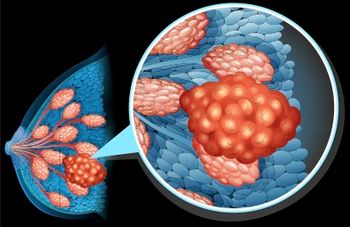
Oncology NEWS International
- Oncology NEWS International Vol 17 No 1
- Volume 17
- Issue 1
Concurrent chemotherapy-PBI feasible with low toxicity
Partial breast irradiation (PBI) with concurrent chemotherapy is feasible and is associated with an acceptable rate of toxicity
LOS ANGELES-Partial breast irradiation (PBI) with concurrent chemotherapy is feasible and is associated with an acceptable rate of toxicity, finds a phase I/II trial presented at the 49th annual ASTRO meeting (abstract 44). In addition, this treatment produces good-to-excellent cosmetic outcomes in most patients.
Delivering chemotherapy and radiation therapy for breast cancer at the same time has several potential benefits, said lead author Richard C. Zellars, MD, of Johns Hopkins Kimmel Cancer Center. These benefits include shortening of the overall duration of therapy, initiation of both therapies closer to surgery, and possibly better local control through a radiosensitizing effect of the chemotherapy.
"Unfortunately, whole-breast radiation and concurrent chemotherapy has been associated with prohibitive toxicities," he commented, with more than 40% of women experiencing grade 4 radiation dermatitis in one study. "But today, with the advent of PBI, the toxicity may no longer be prohibitive."
In the trial, women with resected early-stage breast cancer were treated with dose-dense doxorubicin and cyclophosphamide (AC) every 14 days for four cycles with growth factor support, along with concurrent PBI consisting of 2.7 Gy daily for 15 days (total dose, 40.5 Gy) by external beam.
In terms of dosimetric limitations set for various tissues, Dr. Zellars said, "Please note they were very similar to [NSABP] B-39, except for the heart. In our trial, no more than 10% of the heart received more than 5% of the dose."
Analyses were based on the first 22 consecutive patients. Ten received AC only while 12 received AC plus paclitaxel. Four patients discontinued chemotherapy (mainly because of febrile neutropenia), and four had a delay in chemotherapy. All patients completed radiation therapy.
The most common grade 3 toxicities were nausea and vomiting (three patients) and stomatitis (two patients), Dr. Zellars said. The only grade 4 toxicity was neutropenia (three patients). "This rate of systemic toxicity is comparable to the rate of systemic toxicity seen in patients who receive dose-dense AC alone," he said.
In terms of radiation dermatitis, 4 patients did not have any skin changes; 18 had grade 1 dermatitis; and none had grade 2-4.
During the last week of radiation therapy, cosmesis was good to excellent in 21 patients and poor in 1 patient. At 6 months, cosmesis was good to excellent in all 22 study patients (see Figure).
"PBI as delivered in this trial and concurrent dose-dense AC is feasible," Dr. Zellars concluded. Moreover, the data indicate that the true risk of serious radiation dermatitis does not exceed 13%.
"Short-term cosmetic outcomes appear acceptable. Of course, longer follow-up is necessary to determine late toxicity and local control," he said.
This approach will now be tested with other commonly used chemotherapy regimens, Dr. Zellars said, "and, if safety is confirmed and PBI is shown to offer a similar outcome to whole-breast radiation, a future randomized controlled trial of sequential vs concomitant chemotherapy-PBI may be considered."
Radiation dose too low?
"The early results are very encouraging. The cosmetic results at 6 months were really very good," said Alphonse Taghian, MD, PHD, of Mass General. "I think the radiation dose used in this study might be relatively low. Maybe the authors can think about this in light of the EORTC boost trial, where young women had higher local failure rates," he said (see ONI Dec 2007, page 18).
Articles in this issue
almost 18 years ago
New tobacco product alert: Camel Snus is on the loosealmost 18 years ago
Blueberry punch not quite a 'knock out' blowalmost 18 years ago
Texas voters listen to Lancealmost 18 years ago
Cellectar opens manufacturing facility for radiolabeled CLR1404almost 18 years ago
High cost of breast MRI screening appears to be justifiedalmost 18 years ago
Broccoli Sprouts Extract Might Lower Bladder Cancer Riskalmost 18 years ago
Xeloda/Ixempra Effective in Resistant Triple-Negative Caalmost 18 years ago
Statins during RT may lower risk of prostate ca relapseNewsletter
Stay up to date on recent advances in the multidisciplinary approach to cancer.


















































































